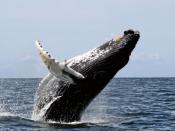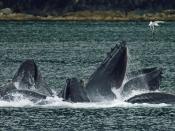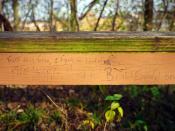A unit On Whales: Combining Language Arts and Science
Author's Note
The purpose of this unit on whales is to capture the attention and motivate them to learn. They will learn about the different types of whales and their descriptions, behaviors and habitats and their importance in our environment. I am an Instructional Aide at a middle school and work with 6th graders. I have discovered different websites that will be very useful in my day to day job with the children. I was surprised to find so much information out there for children that a lot of people don't even know about. In the past I used the basic technology tools that the school provided, but now I am applying the new information I know into my job. I am also sharing these new techniques and tools to the teachers I work with.
This unit is designed to learn about the types of whales, baleen and toothed; several species of whales, their descriptions, behaviors and habitat; and their importance in our environment.
This unit last for six weeks.
This unit is hoped that they will develop a true knowledge and appreciation for whales, as well as create finished products for which they will be proud of.
Standards
State and Local Curriculum Standard and Benchmarks
Grade level: 3-5
Subject area: life science
Standard:
Understands how species depend on one another and on the environment for survival.
Massachusetts English Language Arts Standards
Standard 3: Students adjust their use of spoken, written, and visual language (e.g., conventions, style, and vocabulary) to communicate effectively with a variety of audiences and for different purposes.
Standard 8: Students use a variety of technological and information resources (e.g., libraries, databases, computer networks, and video) to gather and synthesize information and to create and communicate knowledge.
Standard 12: Students use spoken, written, and visual language to accomplish their own purposes (e.g., for learning, enjoyment, persuasion, and the exchange of information).
Standard 8: Understanding a Text
Students will identify basic facts and main ideas in a text and use them as the basis for interpretation
Standard 19: Writing
Students will write with a clear focus, coherent organization, and sufficient detail.
Standard 23: Organizing Ideas in Writing
Students will organize ideas in writing in a way that makes sense for their purpose.
Massachusetts Science and Technology:
Curriculum standard
Standard 1. Students will demonstrate the ability to recognize that animals (including humans) and plants are living things that help grow, reproduce, and need food, air, and water.
36-1 Describe how birds and reptiles have different physical adaptations (e.g. camouflage, senses, etc) and habitats that serve different functions in growth, survival and reproduction (i.e. evolution of whales)
69-6 Communicate observations, results and explanations through discussions, drawings, models, simple graphs, and writing.
National Educational Technology Standards (NETS) for Students 3-5
* National Educational Technology Standards (NETS) for Students
NETS Standard 3: Use developmentally appropriate multimedia resources (e.g., interactive books, educational software, elementary multimedia encyclopedias) to support learning
NETS Standard 4: Use general purpose productivity tools and peripherals to support personal productivity, remediate skill deficits, and facilitate learning throughout the curriculum. (3)
NETS Standard 5: Use technology tools (e.g., multimedia authoring, presentation, Web tools, digital cameras, and scanners) for individual and collaborative writing, communication, and publishing activities to create knowledge products for audiences inside and outside the classroom. (1, 3)
Prerequisite Skills
Students should have the following skills entering into this unit:
Content-Skill
Language Basic Knowledge of reading
Writing skills
Science Basic Knowledge of whales
Basic Knowledge of the habitats of where whales come from
Fine Motor Skills Basic fine motor skills such as drawing and writing and the ability to utilize scissors, tweezers, and glue sticks efficiently.
Information and Communication Technologies Basic Knowledge of Word Processing
Basic Knowledge of Internet
Teacher Web Resources
Adopt a Whale Website http://wildlifeadoption.defenders.org/site/PageServer?pagename=adopt_g_whale
Lesson Plan on Humpback Whales http://www.nationalgeographic.com/xpeditions/lessons/18/g35/cchumpback.html
Lesson Planning Websites: http://www.marcopolo-education.org/home.aspx
Student Web Resources
Habitat and Distribution
http://www.buschgardens.org/infobooks/Baleen/habdisbw.html
Humpback Whales
http://www.kidsplanet.org/factsheets/humpback_whale.html
Searching resources for kids:
http://www.google.com/
http://sunsite.berkeley.edu/KidsClick!/
http://www.ask.com/
Resources Required
Unit Resources
Printed Materials - Books, Maps, Magazines, Posters, etc: Include Author and Title of each print material
1.) Book- National Geographic Judith Rinard
2.) Book- Great Whales Herbert Zim
3.) Book - Whale and Dolphin Vincent Serventy
4.)
Perspective Primary Documents: Include Primary Resource Title and WebLink
1.) Kidspiration
2.) www.languageguide.org
Non-Print Materials - Video/DVD/CD-ROM Resources: Include title and publisher
1.) Dolphins and Friends From the Sea (Video)
2.)
Supplies:
1.) Large chart paper
2.) Markers
3.) Adoption Papers
4.) Colored Pencils
5.) Glue
6.) Whale charts/lists
7.) Construction paper
8.) Poster Board
Check all that apply; add rows for additional items
Hardware: x Computer(s) x Printer
0 Digital Camera
0 DVD Player
x Internet Connection
0 Scanner
0 TV/VCR
x Projection System
Software: 0 MS Word
x MS PowerPoint
0 MS Excel
0 Inspiration
x Kidspiration
x ReadPlease 0 WordWeb
0 Other:
Notes:
Adopt whale kit
Unit Essential Question:
Unit Learning Objectives
1. To provide knowledge about whales
2. To develop many language arts skills as specifically outlined in lessons
3. To teach appropriate group behavior
4. To develop listening skills
5. To encourage creativity
6. To hold student attention
7. To promote group cooperation
8. To develop research skills
9. To promote organizational skills
10. To reinforce reading and writing skills
11. To develop expression through varying media. Unit Guiding Questions
1. What is a humpback whale?
2. What is the difference between baleen and toothed whales?
3. What are the names of the body parts of whales?
4. What is a web?
5. How do you make a web?
6. What is rhyming and rhythm when writing a poem?
Unit Procedure UDL Strategy Technology Tool (s)
Introduction to the Whale Unit`
To introduce the unit on whales by sharing the information in the adoption packet and pamphlet listing the whales by name. (Day 1 30 min.)
To spark interests in different kinds of whales.
State that for the next several weeks they will do a variety of activities to learn about all the whales.
Discuss how they will choose the whale to be adopted.
Discover what they know and want to learn about whales.
1. Cooperate groups
2. Graphic Organizer
3. Handout of presentation for tactile learners.
4. One-on-one instruction
1. PowerPoint
2. Data Projector
Unit Procedure UDL Strategy Technology Tool (s)
Learning Activity 1: Adopting their whale
1. Share the information in the adoption kit and the pamphlet on humpback whales.
2. The student will read the pamphlet with a partner or an adult so they will be able to choose their favorite whale, and state the reason for their choice.
3. The will have the opportunity to nominate a whale for adoption, and then the group will vote. The whale with the most votes will be adopted.
4. Show a colorful whale chart with all the world's whale. Read some of the information on the chart to interest the children.
5. Pair an able reader with a non-reader. Tell the children to read the humpback whale pamphlet with their assigned partner, and place a check beside a whale's name that they find interesting.
6. Two days later the children will nominate their whale. The class will vote to select a whale for adoption.
1. Intranet provides students with access to word document with embedded links- a list of topics and resources.
2. Demonstration of how to access website resources collected by teacher.
3. Graphic organizer
4. Forms for goal setting (topic selection) outline for suggested timetable.
1. Access to school intranet to access adoption papers.
2. Data projector
3. Inspiration graphic organizer placed in shared folder and on CD.
Learning Activity 2: Teach the differences between the baleen and toothed whales.
1. Show the whale charts with several kinds of whales.
2. Show the large diagram of the toothed and baleen whales.
3. Discuss the differences between baleen and toothed whales and how they eat.
4. Have students take turns reading and identifying the parts of the whales on the diagram hung on the wall.
5. Hand out small copies of labeled diagrams of each type of whale for students to study and color.
6. Provide construction paper for students to mount diagrams on.
7. Place diagrams in whale folded construction paper.
1. Graphic organizer
2. MS Word and charts for visual learners
3. Software to create diagram
4. Hands-on experience
1. Microsoft word
2. Read Please
3. Kurzwell
4. Material for poster board
Unit Procedure UDL Strategy Technology Tool (s)
Learning Activity 3: Reading true stories about whales.
1. Gather children into a group.
2. Preview the book.
3. Read the book and tell the children that it is a true story which was reported in the National news.
4. Discuss the story by asking questions (for example: Tell me one fact to remember. How did the story make you feel? What was your favorite part of the story?)
1. Small group activity.
2. Software to assist in reading the text.
3. Print our questions
1. Overhead projector
2. Kid Pix Inspiration
3. Handout of presentation with a space to record each answer to the questions
Learning Activity 4: Video with real whales
1. Instruct students, while they are watching the video, to look for the parts of the whale which are familiar to them.
2. Comment on different parts of the whale while showing film to the students.
3. Discuss with the students what they have learned. Have them tell one fact about whales that they didn't know before.
4. Ask students what their favorite part of the film was and why.
1. Use of outline
2. Inspirationî handouts as organization tools.
1. Use of VCR
2. Power point
3. Video tape
Unit Procedure UDL Strategy Technology Tool (s)
Learning Activity 5: Choose a whale to research
1. Instruct the children to look through the several whale books displayed in the classroom.
2. With help from adults, children will select a book about a specific whale.
3. Adults will read to non-reading students, while the readers read their own whale book.
.
1. Tactile, multi-sensory work
2. Software to assist in reading text
3. One-one one reading
1. Text on-line
2. Use of recorder
Learning Activity 6: Webbing
1. As a group review large example of webbing as a way to organize their knowledge of a subject.
2. Begin with center ring for subject. (eg. Humpback)
3. Have students determine what sub categories of information they want to gather about the subject (eg. The five "W").
4. Have the students provide information in each category.
5. Pass out construction paper and pencils, and divide into groups.
6. With adult and guidance in each small group students will draw and formulate their own web, based on their specific whale and book.
7. When complete each student will add their web to their "whale" folders.
1. Software to create diagram
2. Use of research
3. Students that are not artistic may use software or internet to draw pictures.
4. Demonstrate how to access websites resources and put them into folders
1. Microsoft Word.
2. Computer software.
3 Internet
Unit Procedure UDL Strategy Technology Tool (s)
Learning Activity 7: Creating posters and models
1. Show whale model example.
2. Divide into small groups, each with an adult assistant.
3. Provide students with options of making a model or poster of their whale or both.
4. With an adult assistance encourage each child to help each other in drawing on posters or making models of their whale. Encourage the sharing of strengths.
5. Encourage the labeling of parts of whales and notes of information.
6. Display finished projects in classroom.
1. Use of drawing program for visual and creative learners.
2. Graphic organizer
3. Tactile-hands on activity
4. Step-by-step guideline for completion
5. Cooperative group option
1. Inspiration
2. Microsoft Word
3. Label maker
4. Kid Pix
Activity 8: Whale poems
1. Inform students that they need to think about their whale, and which important facts should be included in their poem
2. Remind them that poetry has rhythm and often rhymes, but not always.
3. Read a few poems from the whale book, asking them to listen for facts, rhyming words, and rhythm.
4. Brainstorm a list of words pertaining to whales to use in their poems, and record on chart paper.
5. Instruct the children to begin their poems. Remind them that they do not have to be perfect, and the adults will be available to help everyone.
6. The more capable students will begin on their own. The adults will be the scribe for the younger students, assisting them with rhyming words and rhythm. (shared writing)
7. Inform the children that all poems will be typed by the adults for them to share at the author's chair. The poems will also be put in a "published" book, for them to take home at the conclusion of the unit.
1. Choice of project/ presentation formats
2. Ties into students' individual interests
3. Cooperative group option
4. Step-by-step guide for completion
1. Storyboard
2. Video Tape (if necessary)
3. Cassette to record poems
4. MS word form to create step-by-step guide
Activity 9: Group Whale Book
1. Instruct the children to look at the vocabulary chart for ideas.
2. Ask them for suggestions.
3. Ask the group if they agree on some of the beginning ideas. Does someone else have a different idea? Do you like this idea better?
4. Once the characters, setting and general ideas are established have the children take turns offering ideas that will fit in the story.
5. Guide the students with questions, such as: Could this happen next? Does this let the reader know what is happening?
6. State that the idea is good, but can they think of a more descriptive word to use here?
7. Re-read the story frequently so the children will know what is happening.
8. Encourage those students who will not participate to try.
9. Re-read completed story and edit for clarity and stronger vocabulary.
10. The adults cut the paper for the book in the shape of a whale, and divide and write text pages and leave pages so there will be one page for each child to illustrate.
11. A few days later each child illustrates a page of their choice.
12. The adults laminate each page and assemble the book.
13. The teacher reads the completed book to the class.
:
1. Tap into students' individual interests
2. Group discussion
3. Step-by-step guide for completion
4. Writing/Drawing to express ideas
5. Cutting and pasting to demonstrate their understanding
1. Paint program (if applicable)
2. CD/ CD burner (if necessary)
3. Song analysis questions to help select appropriate songs and logical reasons for selection. (available on shared drive/CD)
4. MS word form to create step-by-step guide
5 Laminator
Closure Activity: Create Individual Story
1. Divide into very small groups with adult guidance.
2. Discuss what each student would like to say in their story.
3. Have those students that are able to write their own ideas on paper.
4. Adult will help with writing for those who need it.
5. Adults will copy story and type on individual pages for students to begin final process.
6. Students will make illustrations on typed pages.
7. Adult will help students paste pages to construction paper for final copy.
8. Students will do cover title page with their names as authors.
9. Adults will help students make cover pages and put together in book form.
10. Teacher will display finished product.
1. Tactile- hands on.
2. Cooperative groups
3. Opportunity to work with the teacher
1. Microsoft Word
2. Computer use
Learning Extensions - List ways that you could extend the learning on this unit
There are many opportunities to touch on other areas, such as math(measuring and weighing), Science(how whales live and breathe) and social studies(areas of the world that whales inhibit)
With the successful use of these strategies, students will become better writers and readers.
Student Assessment
The students were able to do language arts activities while learning about our great playful ocean whales. Student will have finished the book to display. Students will have shared ideas with others and will have pride in their accomplishments
Unit Rubric
Whale Unit
CATEGORY 3 2 1
How they will choose the whale to adopt Students will choose the whale to adopt by reading about the different whales and state the reason for their choice, by voting. Students will choose the whale to adopt by reading about the different whales. Student does not choose a whale for adoption.
Where and how they live Students understand where the whales live and how they survive in the seas. Students understand where the whales live. Students do not understand where the whales live.
Difference between baleen and toothed whales and how they eat. Students understand the difference between baleen whales and toothed whales by what they eat and how they grow. Students understand the difference between baleen whales and toothed whales by does not know what they eat and how this helps them grow. Students do not understand the difference between baleen whales and toothed whales.
Vocabulary of whales over several days
Student understands the vocabulary words pertaining to the whales and can use them in their sentence writing. Student understands the vocabulary words pertaining to the whales but cannot write them in sentences. Student does not understand the vocabulary words.
Identify the body parts of the whales
Student can identify and match the words to the body parts. Student can identify many different types of body parts. Student cannot identify many different types of body parts.
Information on Whales. Student will be able to web their information based on their research on the specific whale and illustrate pictures. Student will be able to web their information based on their research on the specific whale. Student cannot web their information.


